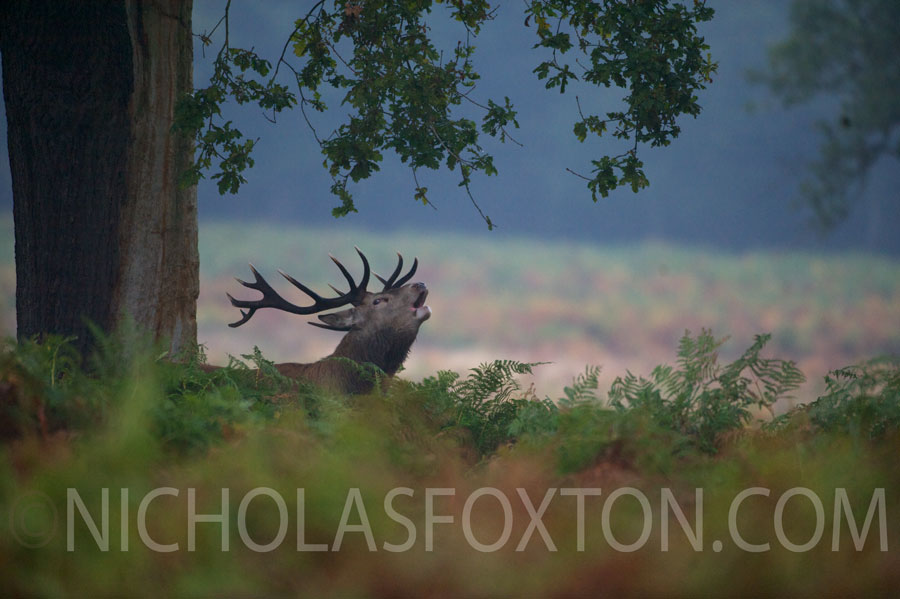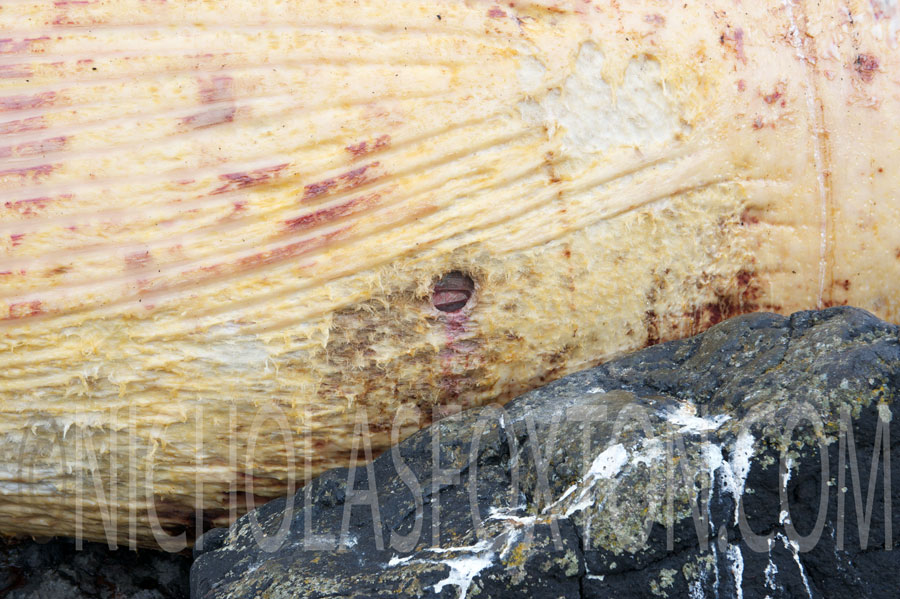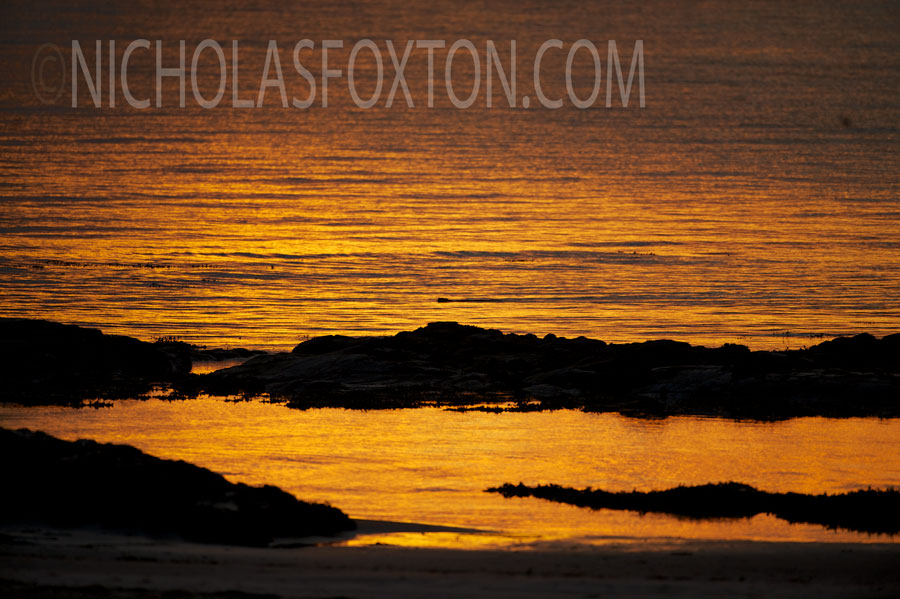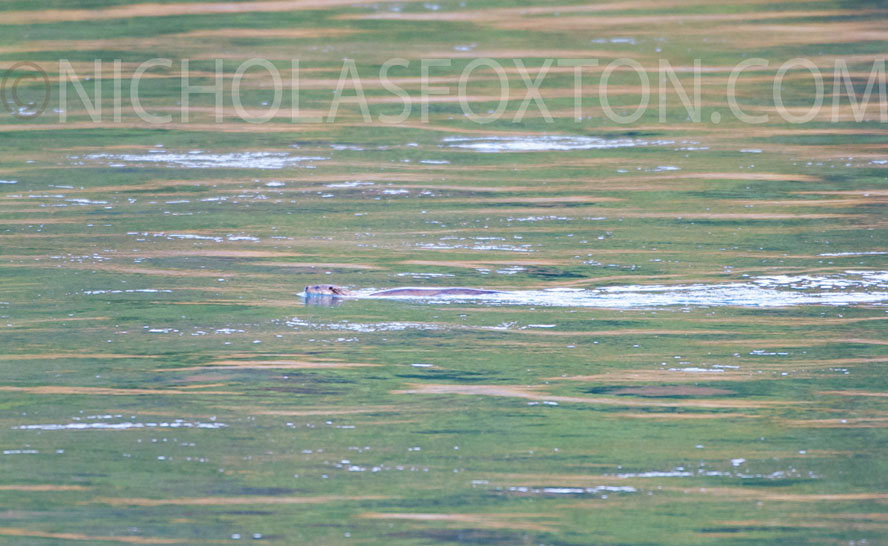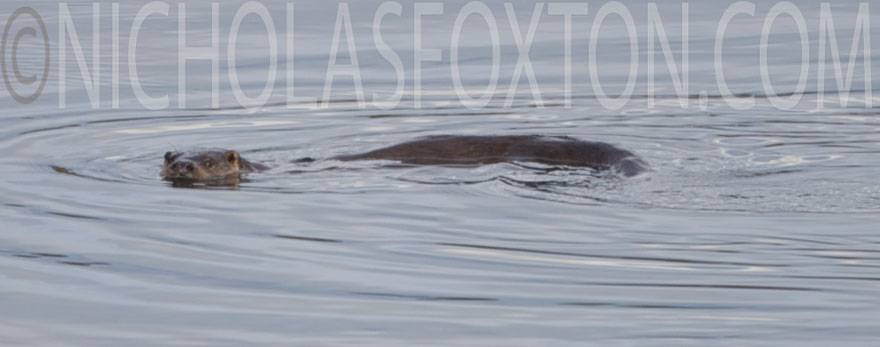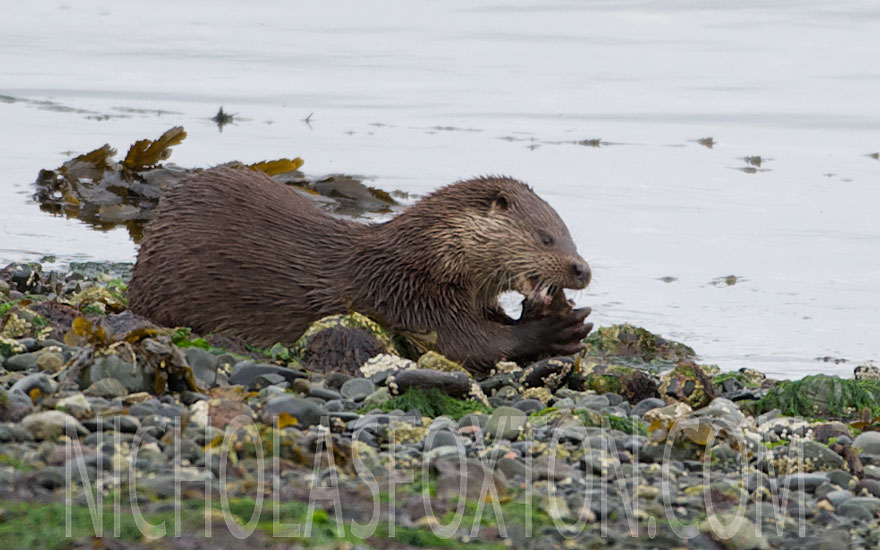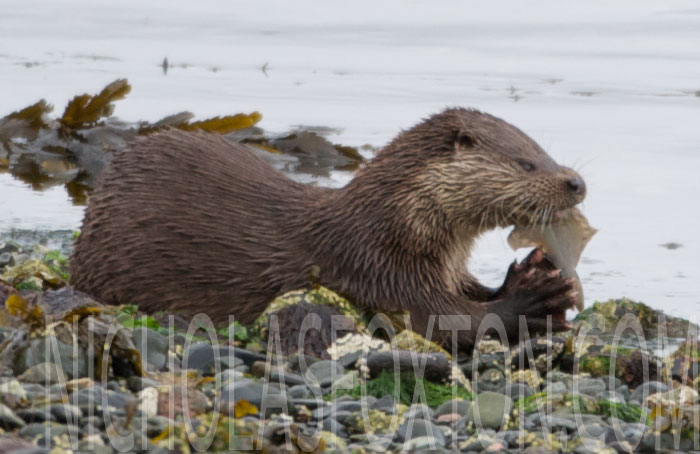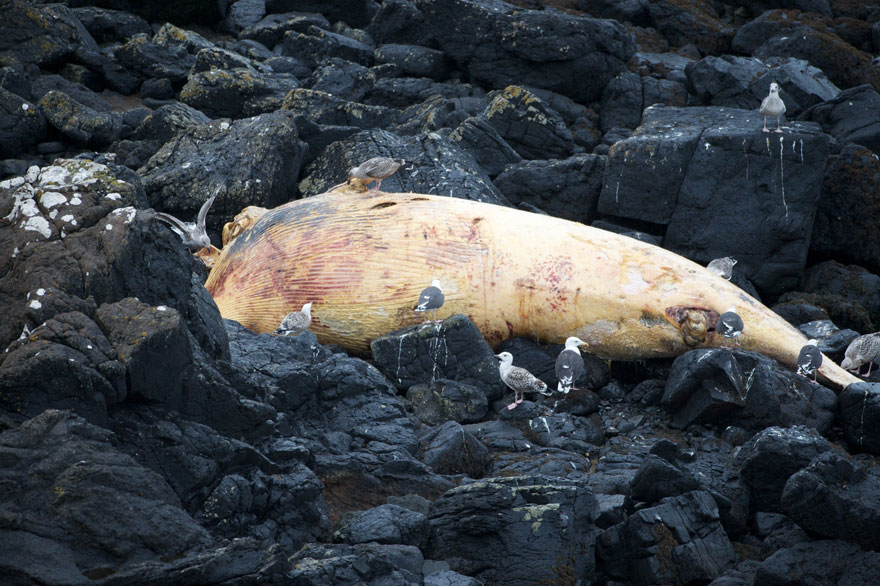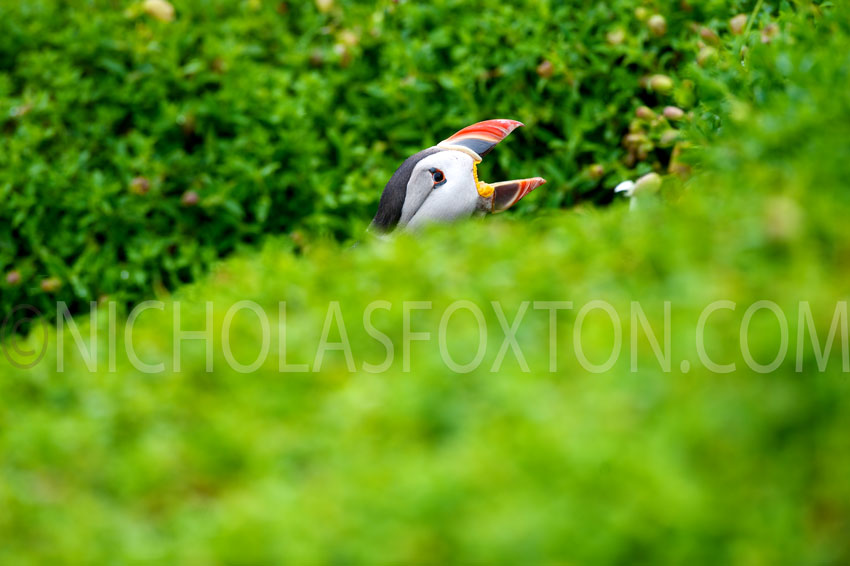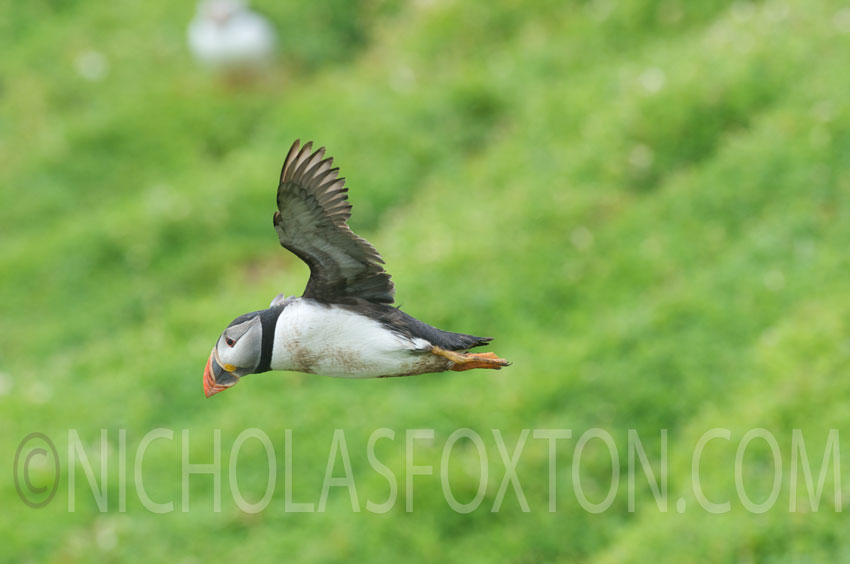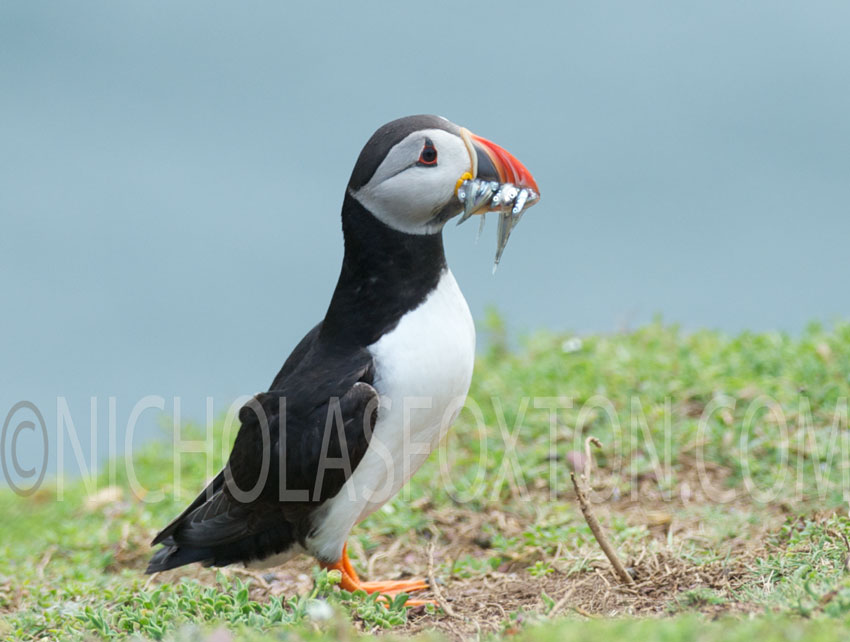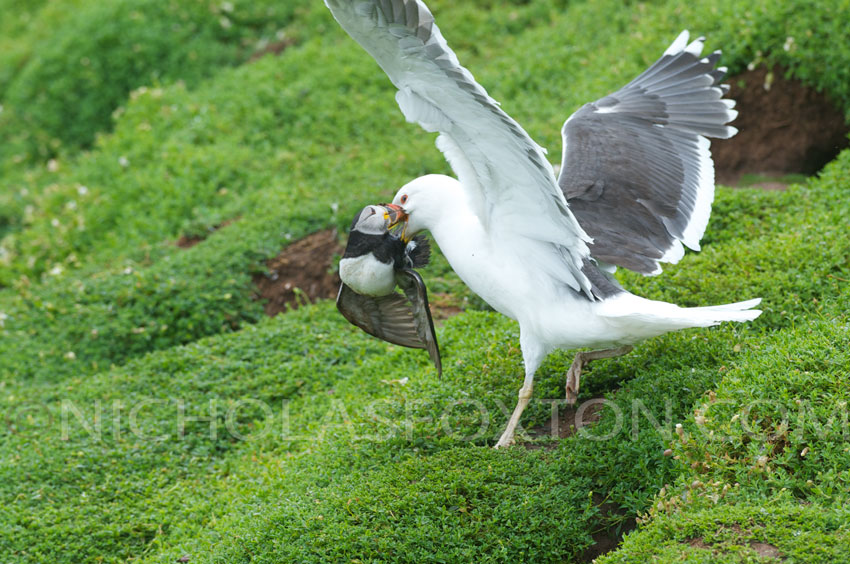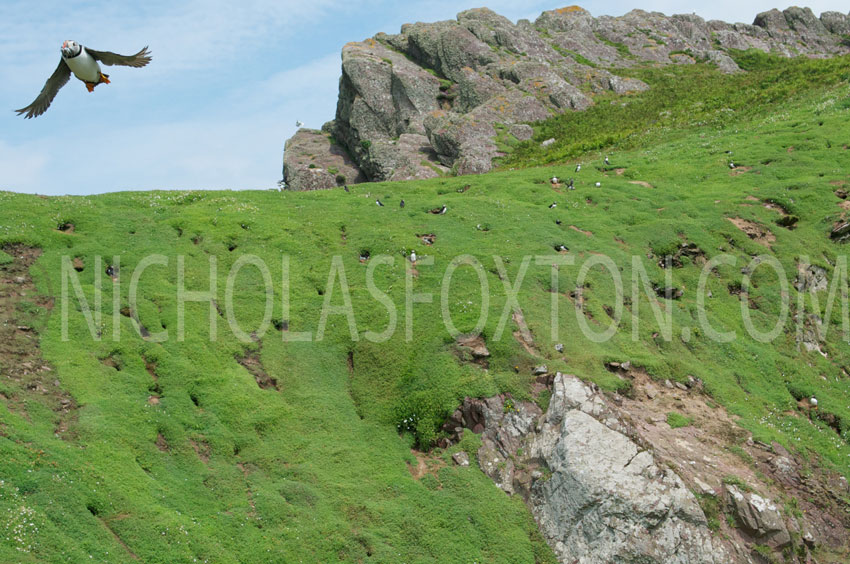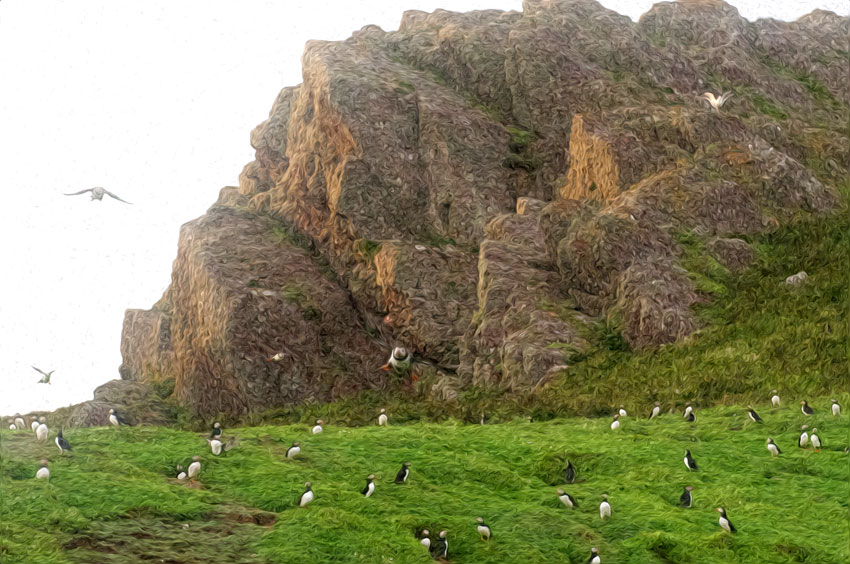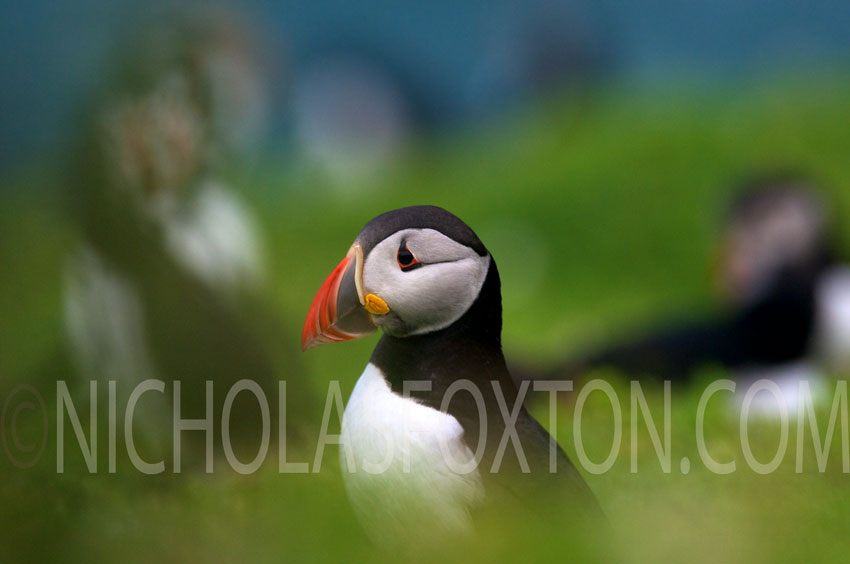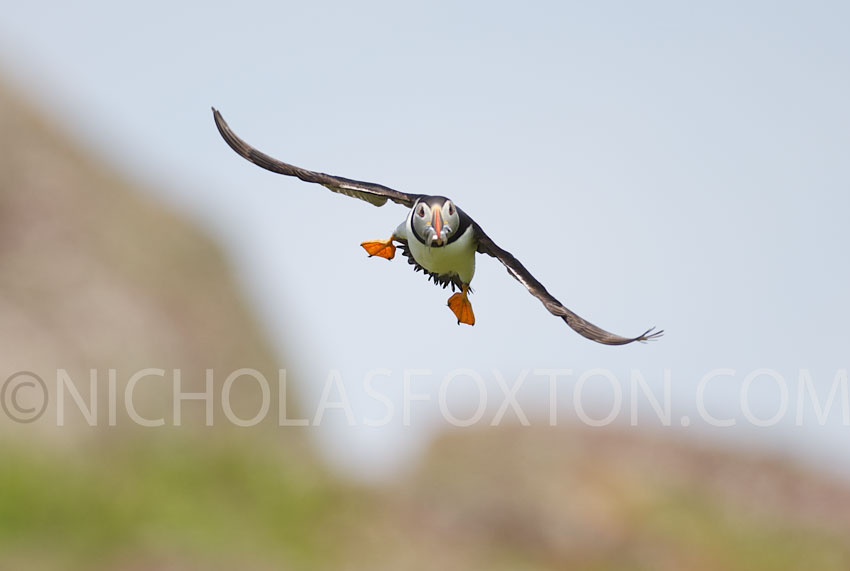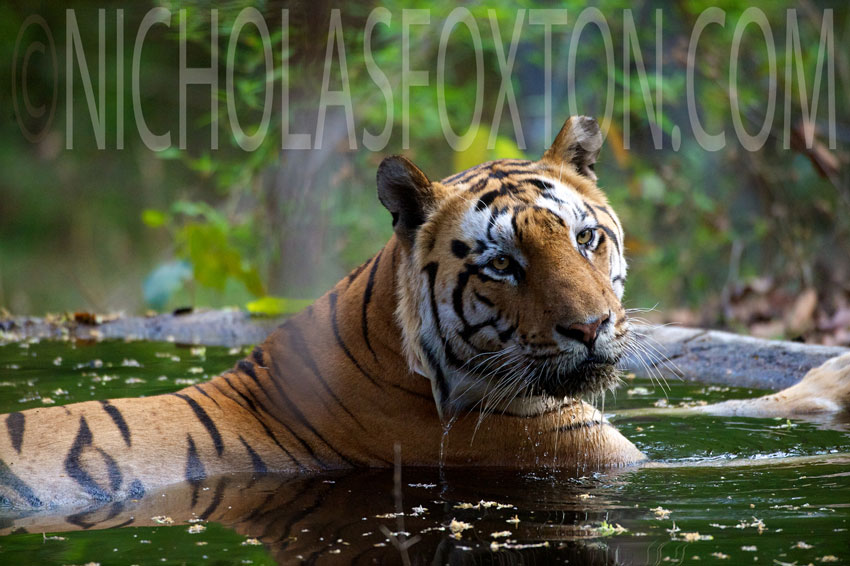Mink are formidable and efficient killers. The rabbit which was squealing frantically was about three times larger than the mink. Mink have colonised Mull having arriving by swimming from the mainland and are thriving despite a trapping campaign. There are theories that they are driven out by otters which are significantly larger and more powerful or that they have carried a viral infection that attacked an otter population that had a weakened immune system due to dieldrin and other organophosphates that decimated otter populations from the 1960′s onwards. No one really knows. 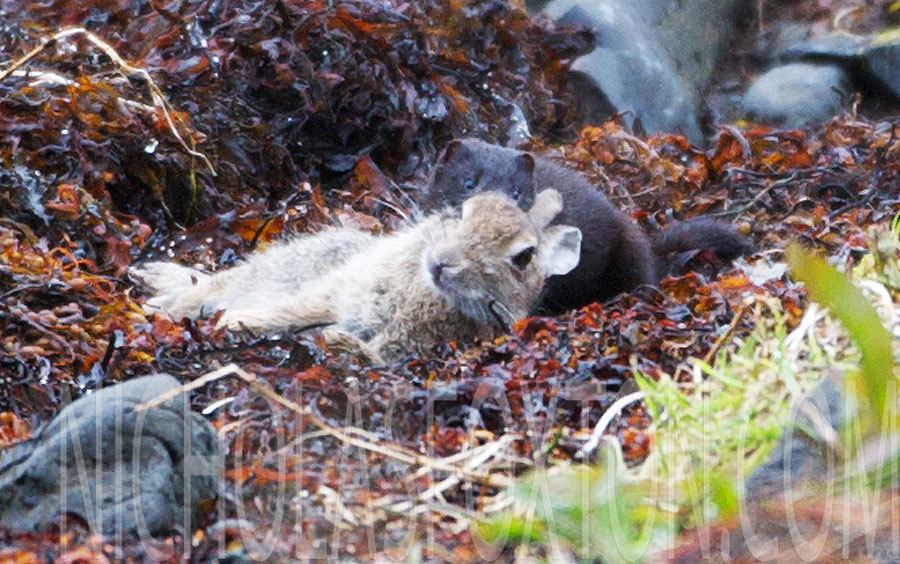
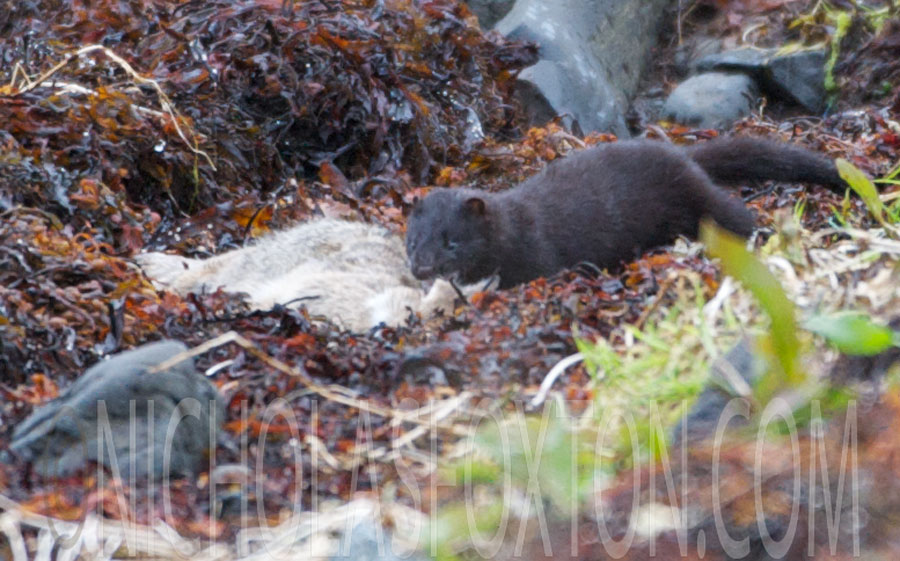
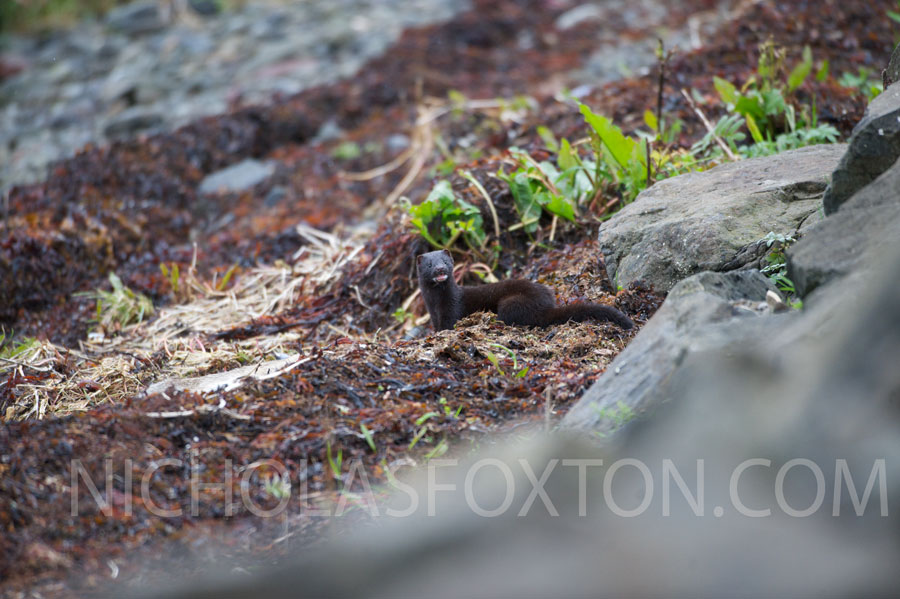
Stag Rut
Minke Whale
This is the carcass of a stranded Minke Whale on Mull. 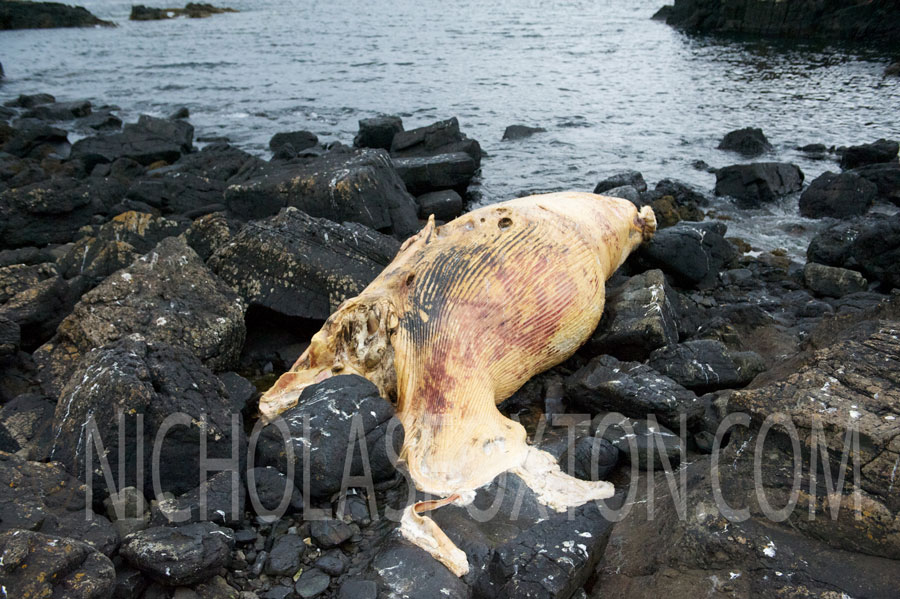
It’s a poignant sight and one that is increasingly common, according to the Hebridean Whale and Dolphin Trust. (www.whaledolphintrust.co.uk). The Trust has a photo album of the whales seen in the waters off Mull.Current theories have linked strandings to the use of sonar by boats, or to general marine pollution, as stranded whales are often found with stomachs full of plastics or tangled in nets. A contemporary version of the finest nineteenth century American novel (Hemingway was wrong to vote for Huck Finn I reckon) would have to have a section on plastics now.
‘What a piece of work is a man’ indeed.
The River God
One of the delights and I can think of no more suitable word of the bivvy (which an incredulous passerby once described with an air of some distaste is ‘sleeping outdoors in a plastic bag’) is the dawn. Mornings like the one in the photo here have me swearing never again to sleep in a house ( which is, as the poet Gary Snyder put it ‘ a box to cage the biped in’.) This is a very early morning view on Mull of a fairly typical view of an otter. It is the long object above the rocks and directly below the T in my watermark. Most otter sightings in Britain are like this if you are lucky. A long series of ripples in the water, the faint swell of the head of the river god, and an eel spine arch to the rudder flick of the tail, as it dives again to disappear. A god of water, a riverine imp sliding under the surface into mystery to elude us like the beast itself.
A Weasel gone to water
I’ve just come back from a week on Mull. For those who don’t know it is one of the best places in Britain for the Otter, the extraordinary secretive mustelid that is the top river predator in Northern Europe. Otters are members of the Lutrinae, a sub-family of the mustelids the same family as the weasels and stoats. They are a weasel that has adapted to living a semi-amphibious life and have long had a totemic quality, by virtue of their appealing appearance. Given that they are crepuscular in habit and rarely seen in the UK during daylight hours it is astonishing to be able to watch them as ‘easily’ as this in Scotland. I say ‘easily’ as the photo above required quite a few hours and a degree of shikari ( which should be interpreted as a hindi euphemism for skulking in the bushes in camouflage at ungodly hours). Not to mention a midge or three. Otters are notoriously shy and secretive and most non marine populations are strictly nocturnal, but Western Scotland is the place to get good daytime views. The one above is eating a flounder, using the powerful back teeth to consume the fish. Here is another shot – I’m grateful to a passing Devonian fisherman (whose name I’ve rudely forgotten) for identifying the fish.
I’ve read a few books on otters this last week, by the flickering light of a campfire while the stags roared around me, and the milky way twinkled like it was twinkling for me alone (apologies for the overwrought nature-writing but I got to sleep out in one of the most beautiful places on earth and am still drunk on it ;’drunk on truth and beauty’ and to watch otters). I’ll blog on otter texts at a later date but wanted to invoke a couple of literary ghosts who were both obsessed with otters, or as James Williams in his book The Otter would have it ‘besottered’. I refer of course to Gavin Maxwell and Henry Williamson, whose works Ring of Bright Water and Tarka the Otter, respectively are such sacred texts for anyone spellbound by the water weasel. They’ve got me too, and watching so elusive an animal is what I’d call a numinous experience.Of which more later.
Western isles
Sand Eels and Puffins
The Atlantic puffin comes into land at about three years of age where it nests in burrows , that it either excavates itself or borrow from rabbits. The vast colonies are a busy sight with the constant chirp of the birds and the flying in and out of the birds as they fish for the Sand Eel, their major food source.
Lurking around are the top predators of the area the gulls, either the Greater Black Backed Gull, Lesser Black Backed or the Herring Gull, which is the aggressor below. This gull waited for the puffin to return to its burrow with a beak stuffed full of fish before attacking – classic ambush predator tactics. The puffin was actually plucked out of the underground burrow and set upon in a rather dramatic scene. The Herring Gull is capable of killing a puffin but does so relatively rarely but was content on this occasion to steal its mouthful of fish.
Skokholm
I’m just back from a week on Skokholm, an island just off the Pembrokeshire coast. If you haven’t been you should- it is one of the beautiful wildlife spots in the UK. It’s noted for the number of nesting seabirds, the most familiar resident is pictured below. 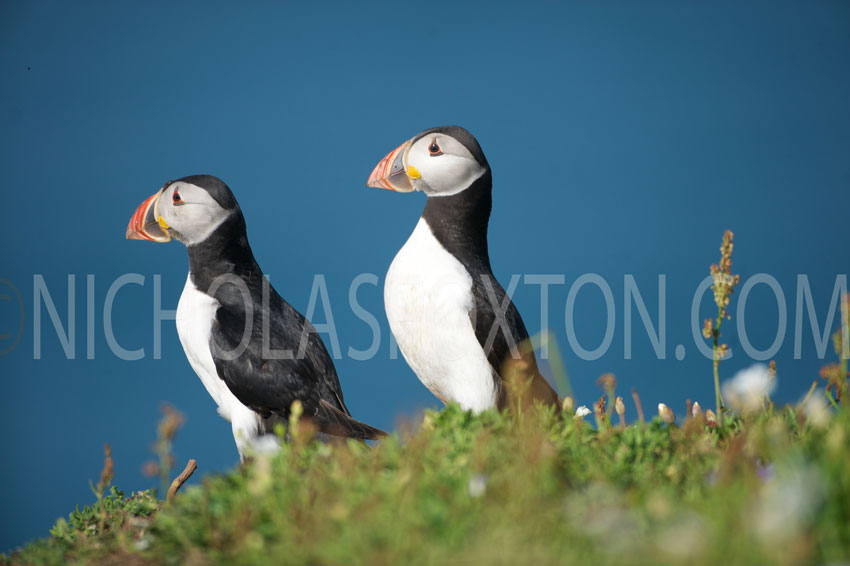
Making reliable estimates of the number of Atlantic puffins on the island is tricky ; the photograph below shows why. This is the area christened Puffin Town by the most famous resident of the island, Ronald Lockley who moved here to farm in 1927.
Here is another photo from the same shot in foul weather.I’ve run this through the Oil paint filter to give it a bit of atmosphere. It was blowing a howling gale when I shot this; the same gale that lasted for three days and kept me on the island as the boat couldn’t land.
This is an incredible place with the constant noise of the puffins as they fly in and out feeding in the crashing waves and returning to their burrows.
Fortunately the weather picked up and I was able to get some better shots.
I had some fine company for the week and there were several of us trying for that elusive perfect puffin flight shot. This is one of my better efforts. Puffins fly like minature torpedos and are hard to catch in sharp focus particularly shooting handheld as I was. I’ve been experimenting with an old Nikon Pistol Grip that I picked up secondhand.
The ethics of dealing with poachers;environmentalism and fascism.
Poachers strike again !
A recent press report has raised the issue of how to deal with the poaching of charismatic megafauna. Here is the news as the Guardian reported it; http://www.guardian.co.uk/environment/2012/may/23/indian-state-forest-guards-poachers?INTCMP=SRCH.
To summarise the Indian state of Maharashtra has announced that the ‘killing or injuring of suspected poachers ‘ will no longer be viewed as a crime’. A fund has also been set up to reward informers whose information leads to poachers. This has been followed by the news that a bounty of 5 Lakh rupees (£5850 or $9000) has been offered by a local politician for anyone shooting a tiger poacher in Eastern Maharashtra.
The context of this is that these ‘initiatives’ reflect a wider anxiety about the number of known poaching related tiger deaths in India in 2012, at least 14 so far, of which 8 have been in Maharashtra. The city of Nagpur in the north of the state is known as a hub for the trade in wildlife parts. Recently the remains of a adult tiger were found in Tadoba Tiger Reserve, missing the head, paws and vital organs, all of which suggests that it was killed for the Chinese ‘medicinal’ trade.
There are several issues so I should set my own position out. My immediate visceral ( and it is a gut-level) reaction is to exterminate the brutes, by which I mean all the human beings involved from the poachers setting the traps all the way up through the chain of middle men to presumably a wealthy end user (who in my imagination always resembles an Oriental Count Dracula) slurping tiger soup to cure his flagging libido. In this fleeting irrational phantasy that ‘will learn them’ to use the Yorkshire vernacular. Of course this will learn no one anything and it takes less than a moments reflection to recognise that such a reaction on my part which grows out of a deep sorrow at human folly and greed towards natural systems is undeniably a fascist response and one that I rationally and rightly refute utterly. No matter that I can recognise that it is an instinctive limbic system response to the threat to something that I love. An admission here; I have days of such extreme sensitivity to such matters that the sight of a fox or badger carcass on the road is a constellation of pain that is almost unbearable. It might be sentimental and given that I’d feel much the same about a dead human being I feel no need to apologise for it. That is the reality of empathy and my personal limits to my instinctive empathy are somewhere around the insects. So I struggle to empathise with the housefly yet can empathise with the magnificent cockchafer that flew into my laptop one evening this week. I’ll have to more to say on that issue of empathy later as that curious complex seems at the heart of what makes us most human. And yet I can’t unthink the unpleasant ‘fascist’ response that was my first reaction to the news of the dead tiger at Tadoba.
And if fascist seems rather a strong term for the response here I point to the fact that the one of the dangers of environmentalism in its more radical forms is that it can skirt moral and philosophical positions that are frequently indistinguishable from fascism. So for instance the local politician offering a reward for the shooting of poachers has expressed an admiration for Adolf Hitler. In mitigation, he has also expressed admiration for Mahatma Gandhi and what is fascinating is the absence of any sense of the necessary extraordinary philosophical contortions required to reconcile the two positions. Of course the expression of support for Hitler’s views that one finds in India are familiar to anyone that travels there regularly; Mein Kampf for sale at airport bookshops for instance.I’d take the view that this kind of view is largely uninformed and this sort of ‘Hitlerism’ is associated with the kind of empowerment of the powerless, much like the teenage Nepali that I shared a bus ride with many years ago whose passionate defence of ‘Auto Fiddler’ was incomprehensible until I got my ear in for the nuances of Nepali pronunciation. I don’t underestimate the ideological appeal of fascism to the disenfranchised or disgruntled (an obvious point) but am more worried about its lure to the political classes whose phantasies tend toward their own personal reruns of the Nurenberg rallies. Perhaps the most sobering thought is that in the complex relationship between human societies and natural systems since we were efficient enough to make a difference that it is the more authoritarian social systems that have preserved the greatest biological diversity. I’ll have more to say about the links between environmentalism and fascism or ‘ecofascism’, in my next post.
Hybrids
I’ve a very nice orchid book complete with great photos and exhaustive detail on British and Irish orchids by Anne & Simon Harrap but some of the site guides are unreliable. So they have the Man orchid as occurring at Hartslock when it has ‘never been anywhere close’ (thanks for that Chris). Which is a shame because of course like all the anthropomorphic orchids (Military, Monkey, Lady/Man) it readily hybridises with close relatives. There is a proto joke in Fauna Brittanica about the ready hybridisation on the continent between Man and Monkey where they have been dubbed ‘missing link’ orchids. I prefer Orchidopithecus, Lucy Orchid, Piltdown orchid etc etc and in time-honoured fashion this peddler of bad puns is getting his coat !






